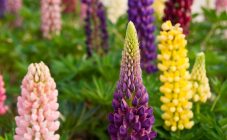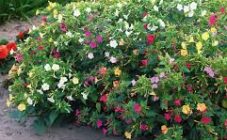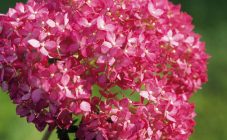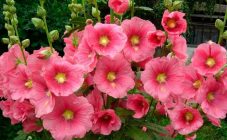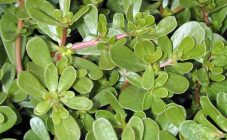Content:
Basil is a plant that is more and more famous for its medicinal and decorative properties among domestic gardeners. This is due to a large number of advantageous features: perennial, blooms beautifully, excellent frost resistance, and is also easy to grow and care for. And the article will tell you everything about the basil: varieties, planting and care features.
Basil flower: botanical description
The plant belongs to the Buttercup family, which is characterized by erect stems with no foliage. The root system is creeping, has triangular basal openwork leaves. Depending on the variety, the culture is capable of reaching 2 m. Numerous miniature flowers are grouped into paniculate, racemose and corymbose inflorescences. They can be pink, white, greenish, lilac, yellow and cream in color. Due to this, basilists are often used for landscape design.
Basil: species and varieties
In total, more than 150 varieties of basil have been bred. The most common among them:
- Small Basil is a uniformly leafy plant that has a nodal root system. The height can reach no more than a meter, the stem can be curved or erect. Leaves of various shapes are formed along the stem. The flowers are characterized by a greenish color; they are grouped in multi-pinnate petiolate inflorescences. The plant blooms from early to mid-summer.
- Basil of Rochebrunsky. Planting and leaving the basil Rochebrunn does not cause difficulties either for beginners or even more experienced florists.
- The stinking basil is a herbaceous crop, the height of which can vary from 15 to 65 cm. Cirrus leaves are characterized by obovate and rounded shapes, the lobes are serrated or whole. Inflorescences are formed from spreading flowers of small size. The color of the fetid flower is yellowish-purple, and the core is yellow. The variety got its name because of the unpleasant aroma that flowers exude during flowering. The buds begin to open, as a rule, in the second - third decade of June and are pleasing to the eye until the end of July.
- Basil yellow has erect stems, their height varies from half a meter to 1.1 m. Leaves of a dull green color and obovate are evenly distributed along the entire length of the stem. Small drooping flowers are grouped into thyroid-paniculate inflorescences. The plant blooms throughout June and July.
- Basil is a perennial flowering herb that can reach 1.2 m in height and grows compactly. The inflorescences of a light lavender color smell nice. The variety blooms for 2 months. It is the basis for the development of new varieties.
- Basil filamentous is a herb for open ground, which can reach a height of no more than 25 cm. White flowers are formed. The culture begins to bloom in mid-May, it is possible to contemplate lush flowering for 3-4 weeks.
There are many more varieties, for example, dipteran basil, magnificent basil, white basil and Cruysch basil, simple, terry, dwarf basil.
Basil: planting and care
It doesn't take much time and money to grow and plant this plant. For active growth and lush flowering, it is important to choose the right place for planting, as well as the time. Basil feels more comfortable in partial shade, therefore, it is better to plant it in a slightly shaded place. Under the influence of direct sunlight, the flowers turn pale and fade.
The optimal time frame for planting a plant in open soil is late autumn or early spring. Plants that are propagated by dividing the bush must be planted exclusively in spring.
This flower can grow successfully on any kind of soil, but, of course, it is better to give preference to fertile and moist. It is important that the soil is free of weeds. There are no special requirements for the chemical composition of the soil.
Shortly before planting, you need to prepare the holes, between them you should maintain a distance of at least 40 cm. Then the planting material is lowered into the holes, sprinkled with earth and carefully tamped. After that, another plentiful watering is needed.
Plant care
The basilist is unpretentious in leaving, he does not need careful care. A perennial plant without transplanting can grow in one place for more than 10 years.
As for watering, the flower is drought-resistant, therefore, it is not afraid of short-term heat. Excess moisture does not have a detrimental effect on the plant. But with a deficit, there will be lush flowering, but, unfortunately, not long.
The culture does not need frequent feeding; it is enough to introduce mineral complexes with an interval of 3 years in the spring. But in preparation for the upcoming wintering, the basil's near-stem circle must be mulched using rotted humus or peat.
The flower also needs pruning. Soon after flowering, the stem is cut at the root. But undersized varieties do not need this. To prevent self-seeding, you need to cut the inflorescences soon after flowering.
All varieties of basil are cold-resistant plants, therefore they do not need careful preparation for wintering. Most varieties are able to withstand air temperature drops down to -30 ° C.
As for diseases and pests, the plant is rarely subjected to such attacks. Perhaps the most common problem, especially in dry weather, that a florist will encounter is aphids. To prevent the formation of colonies on the plant, you need to regularly carry out preventive irrigation using insecticidal preparations. The most common are biotlin, karbofos, tanrek.
Reproduction methods
The plant reproduces in three ways:
Propagation by cuttings
Perhaps this is the easiest way to breed a basil. The only favorable time for breeding is spring. Rhizomes or small sections of the shoot are used as a cutting. Before planting, the cut area must be treated with a disinfectant and growth stimulant.
Cover the plants with agrofibre or a plastic bottle. To prevent the development of fungal diseases or root rot, the basil must be ventilated daily. It is also worth protecting the cuttings from direct sunlight.
Seed propagation
This breeding method is considered the most time consuming. Planting should be done shortly after collecting seeds in mid-September or shortly before the onset of the first frost. Seed material that ripens in August can simply crumble. To prevent this, you will need to tie the inflorescences with gauze in July.Before planting, the planting material must be thoroughly dried.
Basil flowers bloom in the second year after planting.
Dividing the bush
Soon after the onset of spring, before the start of the active growth phase, the bushes must be carefully dug up and divided into the required number of parts. Each constituent must have 1 to 3 buds of renewal. You need to plant the planting material in a semi-shaded place. The land is preliminarily watered abundantly, after which it is mulched. Taking care of the plant is simple, just water it regularly and loosen the soil. If organic and mineral fertilizers were introduced into the soil before planting, then there is no need to fertilize the crop for the next 3 years.
Basil is an ornamental flowering culture that has become widespread due to its medicinal and decorative properties. It will decorate any garden plot, and even a novice florist can grow it.



